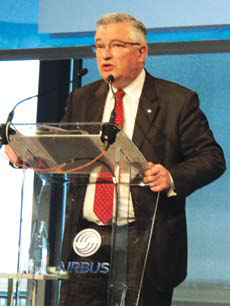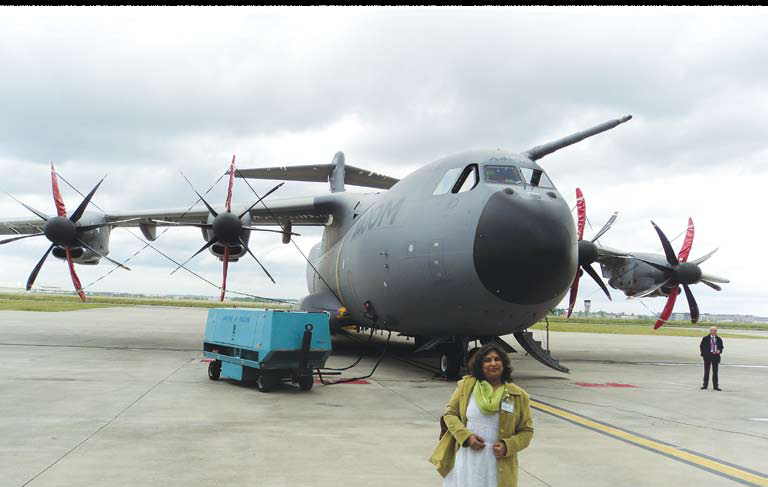|
 “The
test phase will run 1.5-2 months. No real data reduction is needed, so the type
certificate should follow quickly after the test phase is completed,” said Fernando
Alonso, Senior Vice President for Flight and Integration tests. “The
test phase will run 1.5-2 months. No real data reduction is needed, so the type
certificate should follow quickly after the test phase is completed,” said Fernando
Alonso, Senior Vice President for Flight and Integration tests.
Airbus Military’s strategy is to focus on emerging markets, including Africa, the
Asia-Pacific and Latin America, as budgets are growing in the Middle and Far East.
As part of its marketing efforts, the company recently sent the A400M on a tour to
Latin America and Asia and is actively marketing the airlifter there. Airbus Military
is making a major effort in Peru and hopes to increase its presence in Mexico. It also
recently created Airbus Military Brazil.
“Airbus Military’s strategy is to offer highly versatile aircraft, as these have the best
chance of obtaining market success. Our company’s product line has been growing despite
challenges, Airbus Military remains committed to delivering new aircraft,” Head of Airbus
Military Domingo Urena-Raso said.
He was addressing the annual Trade Media Briefing 2012.
The A400M in its paratrooping role, will be able to drop supplies from both high and low
altitudes, as high as 40,000 ft for special forces’ operations, and as low as 15ft for low
level load deliveries. It can accommodate up to 116 troops sitting face to face, along the
sides of the fuselage and back-to-back along the centre line of the aircraft.
Due to its wider fuselage which provides more space between the rows, it can carry the same
number of fully equipped paratroopers with their parachutes and related equipment.
 “The
A400M has been specifically designed to allow very rapid dropping. On the one hand, its
low speed performance (as low as 110 kt/200 km/hr) enables an easy exit from the aircraft.
This reduces the dispersion of paratroops and thus permits easier regrouping on the ground.
But above all, the A400M allows two paratroopers to jump simultaneously either from the cargo
ramp or through the two lateral doors. This alone reduces the jumping time – and hence the
scatter between the first and last to jump - by 50 per cent,” said Cedric Gautier, Head of
A400M Programme. “The
A400M has been specifically designed to allow very rapid dropping. On the one hand, its
low speed performance (as low as 110 kt/200 km/hr) enables an easy exit from the aircraft.
This reduces the dispersion of paratroops and thus permits easier regrouping on the ground.
But above all, the A400M allows two paratroopers to jump simultaneously either from the cargo
ramp or through the two lateral doors. This alone reduces the jumping time – and hence the
scatter between the first and last to jump - by 50 per cent,” said Cedric Gautier, Head of
A400M Programme.
A400M has a payload/range of any airlifter able to perform tactical missions, while also being
able to fly long-range strategic sorties. The aircraft can carry up to 37 tonnes of cargo over
a distance of 1,780 nm/3,300 km or, when trading cargo for range, 30 tonnes over 2,450 nm/4,500
km, or 20 tonnes of cargo a distance of 3,450 nm/6,400 km, which is more than twice that of
inservice tactical airlifters with a similar load. It can also achieve this much faster because
of its high cruise speed of up to Mach .72.
Its fuselage external width of 5.64 metres/18 ft 6 in is equal to that of the A330/A340 wide-body.
The inside usable width of four metres/13ft, height of up to four metres/13ft, and usable length
of nearly 18m/59ft, altogether with the 5.4 m/18 ft long ramp capable of handling up to six tonnes/
13,200 lb on its own, allows it to carry numerous items of outsize cargo, including, vehicles and
helicopters that are too large or too heavy for existing tactical airlifters.
“For military purposes, it can carry either an NH90 or a CH-47 Chinook helicopter, or two Stryker
infantry carrier vehicles (ICVs).
It can also carry a semi-articulated truck with a 6m/20ft container, or a rescue boat, or large
lifting devices, such as excavators or mobile cranes that are urgently needed to assist in disaster
relief.
Or it can carry a combination of these materials while offering up to 54 seats for troops, or search
and rescue teams, medical support, engineers, and so on.
But it can also conduct crossloading with larger strategic transports without the need to reconfigure
loads in hub and spoke operations. A sophisticated cargo handling system, with winch and optional powered
crane, allows loading and unloading by a single loadmaster without ground assistance at the most remote and
austere strips, minimising vulnerable time on the ground,” stated Miguel Angell Morell, Senior Vice President,
Head of Engineering.

A400M is not only an airlifter and troop transporter but can also be converted into an air to air refuelling
tanker. It has been conceived from the outset for this dual role, providing enhanced utilisation of the aircraft.
In fact, the A400M is the only Tanker which can refuel the entire range of probe-equipped military aircraft at
their preferred speeds and altitudes.
This is because it can fly both at the low speeds (105 to 115 kt indicated air speed) and altitudes up to 5,000
ft, typical to refuel helicopters (such as the AW101 Merlin, CH-53 Sea Stallion, EC725 Caracal, HH-60 Pave Hawk),
as well as at speeds of 280 to 300 kt and altitudes of around 25,000 ft which are typical for fast jets, such as
fighters (Eurofighter, F/A-18 Hornet, Mirage, V-22 Osprey, for example), or for large aircraft such as the C295,
C-130, or even another A400M for buddy refuelling.
For this, the A400M is equipped with a nose probe mounted above the cockpit. which can easily be removed when it
is not needed. Refuelling can be done either through two hose and drogue under-wing refuelling pods sor through
a centre-line fuselage refuelling unit (FRU). Its built-in air-to-air refuelling capability allows it to be rapidly
re-configured to become a tanker.
With hard points, fuel lines and electric connections already built into the wings, it takes under two hours to convert
the A400M from an airlifter into a two-point tanker aircraft. The two hose and drogue under-wing refuelling pods can
provide a fuel flow of up to 400 US gal/1,500 litres per minute. The refuelling can also be done through a centre-line
Hose and Drum Unit (HDU) which provides a fuel flow of some 600 US gal/2,250 litres per minute. Three video cameras can
also be installed, to monitor the refuelling from the wing pods and the centre-line unit.
“The A400M can also be refuelled itself. For this, it is equipped with a nose probe mounted above the cockpit. This
increases the range of the A400M. The A400M carries up to 50.5 tonnes/111,330 lb of fuel in its wings and centre wing
box. Two additional cargo hold tanks can also be installed, providing an additional 5.7 tonnes/12,600 lb of fuel each.
The fuel carried in the extra tanks can be of a different nature to the fuel in the main tanks. This enables the A400M
to cater for the needs of different types of receiver aircraft. Also, because of its low fuel consumption, the A400M
can offload some 35 tonnes/77,000 lb of fuel on a four-hour mission,” said Antonio Caramazana, Vice President, Head
of Airbus Military Derivatives.
|